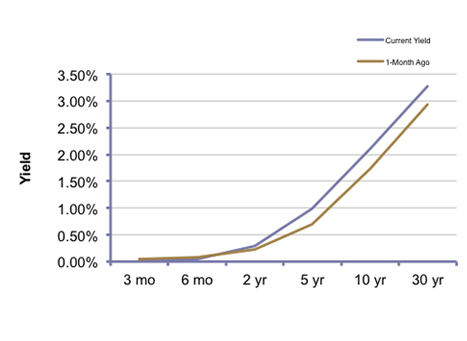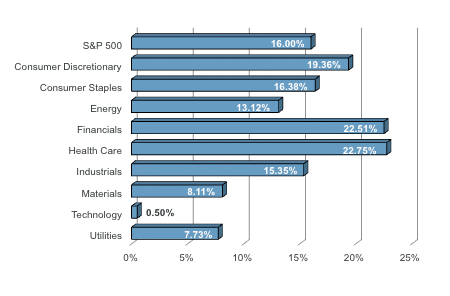Market Commentary by Scott J. Brown, Ph.D., Chief Economist
 U.S. market participants continued to fret about Federal Reserve policy, debating when policymakers would dial down the rate of asset purchases and what that would mean for the economy and long-term interest rates. The market volatility surrounding the Fed’s decision is somewhat puzzling.
U.S. market participants continued to fret about Federal Reserve policy, debating when policymakers would dial down the rate of asset purchases and what that would mean for the economy and long-term interest rates. The market volatility surrounding the Fed’s decision is somewhat puzzling.
Recall that the Fed has a qualitative threshold for the asset purchase program: “substantial improvement” in labor market conditions. That phrase means different things to different Fed officials. The total level of Fed purchases is what matters, not the monthly pace. There was no appreciable increase in long-term interest rates when QE1 and QE2 ended. QE3 differs in that it is open-ended. We don’t know exactly when it will end and what the total amount of purchases will be. So, the total amount of Fed purchases is unclear.
Note that a $500 billion change in total Fed asset purchases is roughly equivalent to about 20 basis points in the 10-year Treasury yield. The difference between tapering the rate of asset purchases sooner rather than later doesn’t have that much of an impact.Investors may, of course, worry about the end of unusually accommodative monetary policy, but the near-term economic outlook has softened a bit recently, inflation has continued to trend at a low level, and the federal budget deficit is falling more than anticipated – none of that suggests upward pressure on long-term interest rates.
Moreover, even if the Fed were to stop buying completely, that would not be a tightening of monetary policy (which would occur when the Fed begins to reduce the size of its balance sheet).
Next week, no changes are expected out of the Fed’s policy meeting. The focus should be on Bernanke’s post-meeting press briefing, where the Fed chairman should provide a crisp explanation of what the Fed expects and what conditions will dictate a reduction in the rate of asset purchases. He’s likely to counter any expectations that a tapering would come anytime soon.
Indices
| Last | Last Week | YTD return % | |
| DJIA | 15176.08 | 15040.62 | 15.81% |
| NASDAQ | 3445.37 | 3424.05 | 14.10% |
| S&P 500 | 1636.36 | 1622.56 | 14.74% |
| MSCI EAFE | 1676.65 | 1669.61 | 4.53% |
| Russell 2000 | 989.69 | 979.46 | 16.52% |
Consumer Money Rates
| Last | 1-year ago | |
| Prime Rate | 3.25 | 3.25 |
| Fed Funds | 0.09 | 0.18 |
| 30-year mortgage | 3.98 | 3.71 |
Currencies
| Last | 1-year ago | |
| Dollars per British Pound | 1.569 | 1.555 |
| Dollars per Euro | 1.333 | 1.258 |
| Japanese Yen per Dollar | 94.500 | 79.380 |
| Canadian Dollars per Dollar | 1.017 | 1.026 |
| Mexican Peso per Dollar | 12.750 | 13.973 |
Commodities
| Last | 1-year ago | |
| Crude Oil | 96.69 | 82.62 |
| Gold | 1378.77 | 1615.25 |
Bond Rates
| Last | 1-month ago | |
| 2-year treasury | 0.28 | 0.23 |
| 10-year treasury | 2.15 | 1.93 |
| 10-year municipal (TEY) | 3.68 | 3.02 |
Treasury Yield Curve – 06/14/2013
S&P Sector Performance (YTD) – 06/14/2013
Economic Calendar
| June 18th |
— |
Consumer Price Index (May) Building Permits, Housing Starts (May) |
| June 19th |
— |
FOMC Policy Decision, Bernanke Press Briefing |
| June 20th |
— |
Jobless Claims (week ending June 15th) Philadelphia Fed Index (June) Leading Economic Indicators (May) Existing Home Sales (May) |
| June 25th |
— |
Durable Goods Orders (May) Consumer Confidence (June) |
| June 27th |
— |
Empire State Manufacturing Index (June) Homebuilder Sentiment (June) |
| July 4th |
— |
Independence Day Holiday (markets closed) |
| July 5th |
— |
Employment Report (June) |
| July 31st |
— |
Real GDP (advance 2Q13 + comprehensive revisions) FOMC Policy Decision (no press briefing) |
Treasury Yield Curve – 05/31/2013
S&P Sector Performance (YTD) – 05/31/2013
Economic Calendar
| June 3rd |
— |
ISM Manufacturing Index (May) Motor Vehicle Sales (May) |
| June 4th |
— |
Trade Balance (April) |
| June 5th |
— |
ADP Payroll Estimate (May) ISM Non-Manufacturing Index (May) Fed Beige Book |
| June 6th |
— |
Jobless Claims (week ending June 1st) |
| June 7th |
— |
Employment Report (May) |
| June 13th |
— |
Retail Sales (May) |
| June 14th |
— |
Industrial Production (May) |
| June 19th |
— |
FOMC Policy Decision, Bernanke Press Briefing |
| July 4th |
— |
Independence Day Holiday (markets closed) |
| July 31st |
— |
Real GDP (advance 2Q13 + comprehensive revisions) FOMC Policy Decision (no press briefing) |
Important Disclosures
US government bonds and treasury bills are guaranteed by the US government and, if held to maturity, offer a fixed rate of return and guaranteed principal value. US government bonds are issued and guaranteed as to the timely payment of principal and interest by the federal government. Treasury bills are certificates reflecting short-term (less than one year) obligations of the US government.
Commodities trading is generally considered speculative because of the significant potential for investment loss. Markets for commodities are likely to be volatile and there may be sharp price fluctuations even during periods when prices overall are rising. Specific sector investing can be subject to different and greater risks than more diversified investments.
Tax Equiv Muni yields (TEY) assume a 35% tax rate on triple-A rated, tax-exempt insured revenue bonds.
![]() Material prepared by Raymond James for use by its financial advisors.
Material prepared by Raymond James for use by its financial advisors.
The information contained herein has been obtained from sources considered reliable, but we do not guarantee that the foregoing material is accurate or complete. Data source: Bloomberg, as of close of business May 31st, 2013.
©2013 Raymond James Financial Services, Inc. member FINRA / SIPC.







